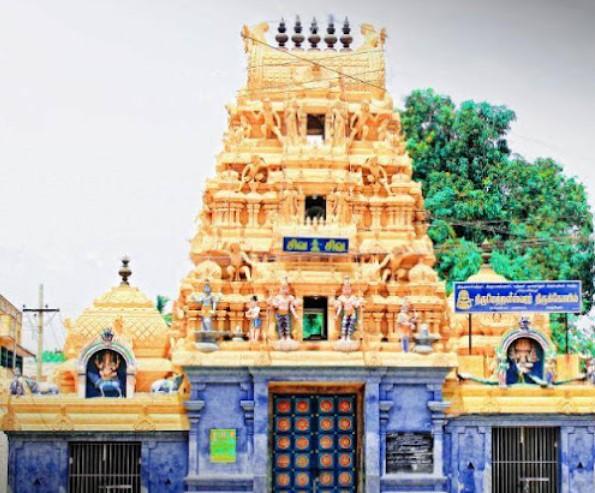The temple is believed to have been originally built by the Pallavas and later expanded during the 13th century by the Cholas, as indicated by inscriptions.
Sthala Puranam of Odhavurugeeswarar Temple, Mettraliyur
Lord Vishnu, reclining in the milk ocean, had a strong desire to assume the form of a Shiva Linga. Determined to fulfill this wish, He approached Lord Shiva, but Shiva expressed His inability to grant the request. Undeterred, Vishnu began intense penance on Shiva, showcasing His unyielding devotion.
Lord Shiva, impressed by Vishnu's persistence, revealed that Vishnu could attain His desire by performing penance at a specific place, facing west, in the form of His Swayambu. Vishnu then traveled to this sacred location, Mettraliyur, and began His penance facing east, after taking a holy dip in the Vegavati River.
During this time, the great saint Tirugnana Sambandar was also visiting Mettraliyur. He saw Lord Vishnu in His penance, facing the opposite direction and assumed that He was worshiping Lord Shiva. The saint, moved by divine inspiration, began singing hymns in praise of the Lord. Vishnu, touched by the saint's melodious hymns, began to melt in devotion.
As Vishnu melted, His Linga form manifested, but His feet remained. This miraculous event led to the temple being renowned for housing both the Shiva Linga and Vishnu’s feet in the sanctum sanctorum.
The name of the deity came to be known as Odhavurugeeswarar:
Odha – meaning singing (referring to the saint’s hymns).
Urugu – meaning melting (referring to Vishnu’s melting form).
Easwarar – meaning God (referring to the divine presence of Lord Shiva and Vishnu).
This sacred place, where Vishnu's devotion led to a divine transformation, continues to be a place of immense spiritual significance, drawing devotees for blessings and divine darshan.
PURANIC SIGNIFICANCE:
Odha Urugeeswarar:
According to legend, Lord Vishnu, reclining in the Milk Ocean, wished to assume the form of a Shiva Linga. He approached Lord Shiva with this desire, but Lord Shiva initially expressed his inability. Undeterred, Lord Vishnu began penance, and moved by his determination, Lord Shiva finally relented, offering him the ability to transform on the condition that Vishnu perform penance at a specific place on his Swayambhu (self-manifested) Shiva Linga, facing west. Additionally, Lord Shiva told Vishnu to continue his penance until Thirugnana Sambandar visited and praised him.
Vishnu, after bathing in the Vegavathi River, stood facing east in penance. Saint Thirugnana Sambandar visited Mettraliyur and, seeing Vishnu in penance, mistook him for Lord Shiva, as Vishnu’s back was visible. The saint began to sing in praise of the Lord. Moved by the devotion in the saint's song, Vishnu began to melt, transforming into a Linga form, though his feet remained visible. Thus, Lord Shiva is known as Odha Urugeeswarar (Odha – singing, Urugu – melting, Easwarar – Lord Shiva). In the Odha Urugeeswarar Shrine, both the Shiva Linga and the holy feet of Vishnu can still be seen.
Metrali Nathar:
According to legend, Lord Shiva originally faced east in this temple. Upon hearing the hymns sung by Saint Thirugnana Sambandar in praise of Odha Urugeeswarar, Lord Shiva turned west to listen more intently. As a result, Lord Shiva came to be called Metrali Nathar (Merku – west, Thali – temple, and Nathar – Lord Shiva), and the place became known as Thirumetrali.
Utru Ketta Muktheeswarar:
While singing praises of Thirumetralinaadhar, Saint Thirugnana Sambandar stood outside the temple. Moved by the saint's hymns, Lord Shiva, wishing to hear them more clearly, stepped forward from his position in the temple and transformed himself into a Linga. Thus, he became known as Utru Ketta Muktheeswarar. Interestingly, the hymns of Sambandar that praise Lord Shiva at the Metraleeswarar temple have not been found. This temple is situated between the Metraleeswarar and Thirugnana Sambandar temples.
Thirugnana Sambandar Temple:
It is believed that Saint Thirugnana Sambandar, while singing hymns in praise of Lord Shiva at the Thirumetralinaadhar Temple, did so from the end of the street. His shrine is located at the site where he is said to have composed these hymns. Notably, the hymns of Sambandar dedicated to Lord Shiva of Metraleeswarar temple are absent.
Pillayar Palayam:
As Saint Thirugnana Sambandar is also known as Aludaipillayar and Sambanda Pillayar, the place where he sang hymns came to be called Pillayar Palayam, and is also referred to as Pachimalayam.
Budha Worshipped Lord Shiva Here:
It is believed that Budha, one of the Navagrahas, worshipped Lord Shiva at this site.
People Worshipped Lord Shiva Here:
A significant number of devotees are said to have worshipped Lord Shiva at this temple, including 100 Rudras, Sikandar, Veerabhadra, Krodha, Mandalathipathis, and a total of 116 devotees.
ADMINISTRATION:
It is currently maintained and administered by the Hindu Religious and Charitable Endowments Board of the Government of Tamil Nadu.

